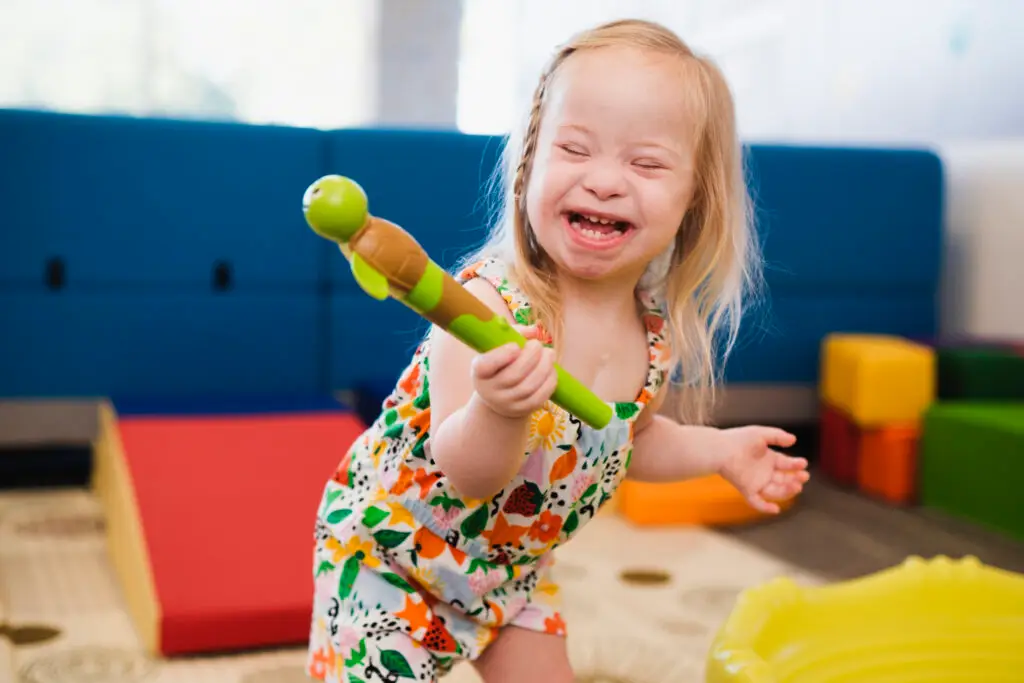This article is part of The Talk with April Anderson—TalkTools’ monthly series for feeding professionals. Each edition delivers family-centered guidance and practical, evidence-based strategies you can use in therapy and in caregiver coaching.
Vibration tools in feeding therapy can be powerful and versatile—yet many clinicians and caregivers approach them with caution. In this edition of The Talk with April Anderson, we outline evidence-based ways to integrate vibration tools in feeding therapy to support oral awareness, desensitization, and motor activation, with practical ideas you can use in sessions and caregiver coaching.

Why Use Vibration in Feeding Therapy?
Feeding is one of the most complex skills a child learns — it requires coordination of sensory awareness, motor control, strength, endurance, and timing. Many children referred for feeding therapy present with challenges in one or more of these areas: reduced oral awareness, sensory aversion, low muscle tone, or difficulty transitioning to new textures.
Vibratory input offers a unique way to support these underlying skills. It provides strong, consistent sensory feedback and helps activate muscles and reflexes involved in oral motor patterns. From a motor perspective, vibration can also facilitate neuromuscular activation — gently stimulating the muscles of the lips, tongue, and jaw to improve tone, coordination, and motor planning. For children with oral sensory processing differences or neuromotor challenges, this can be the “just right” level of stimulation to help their system respond more effectively.
Used purposefully, vibration tools in feeding therapy provide targeted input that supports oral awareness, sensory regulation, and more efficient therapy outcomes.
Looking for tools? Explore TalkTools® Sensi® and the Vibration collection for clinic and home-program options.
Clinical Benefits of Vibration Tools in Feeding Therapy
Increase Oral Awareness
Children with hyposensitivity (reduced oral awareness) may drool, pocket food, or struggle to manage boluses because their brains aren’t getting enough sensory information. Vibration “turns up the volume” on sensory feedback, helping them better perceive and respond to oral input.
Reduce Oral Aversion and Hypersensitivity
For children who are defensive about oral touch, vibration can serve as a desensitization tool. By providing consistent, predictable sensory input, it helps the nervous system recalibrate and become more tolerant of varied oral sensations — an important step in expanding food acceptance. For a deeper dive into tactile defensiveness and oral aversion, see TalkTools’ text by Overland & Merkel-Walsh and related TOTs resources.
Facilitate Muscle Activation
Vibration can “wake up” oral motor patterns in children with low tone or poor strength. Applying it to the lips, cheeks, or jaw before feeding tasks may prime muscles for better movement and coordination during eating and drinking.
Support the Transition to Oral Feeding
For children transitioning from tube to oral feeds, vibration can reintroduce oral stimulation in a controlled, strategic way — helping to rebuild both sensory processing and oral motor skills needed for functional feeding. See Feeding Therapy: A Sensory-Motor Approach for training that integrates sensory and motor frameworks.
In practice, vibration tools in feeding therapy can increase oral awareness, reduce aversion, and facilitate muscle activation across a variety of clinical profiles.
Who Might Benefit Most from Vibration Tools in Feeding Therapy
- Children with oral hyposensitivity or low tone
- Children with oral aversion or significant sensory defensiveness
- Children with neuromotor conditions impacting feeding
- Children with delayed chewing, bolus manipulation, or tongue movement
Learn more from April’s related trainings: Thinking Outside the Fridge (Early Intervention) and The Three C’s of Feeding Therapy with the Tube-Fed Child.
Vibration Tools and Techniques in Feeding Therapy

Developmental Readiness for Vibration Tools in Feeding Therapy
Before incorporating vibration, ensure that the child:
- Has no contraindicated medical conditions (e.g., uncontrolled seizures, significant oral lesions)
- Tolerates basic oral touch without distress
- Demonstrates at least minimal interest in mouthing or oral exploration
For general choking-safety guidance to share with caregivers, refer to the AAP/HealthyChildren.org guide.
Common Vibration Tools in Feeding Therapy
- Sensi or similar oral motor tools: Designed for targeted stimulation of lips, tongue, gums, and cheeks.
- Vibrating toothbrushes: Great as a low-cost option for home programs and parent carryover.
- Vibrating spoons or feeders: Useful for transitioning to food introduction.
- Vibrating toys: Low stress way for more reserved children
Supervision and hygiene are key. Follow manufacturer instructions and clinic protocols. Discontinue use if adverse responses occur. For printable clinic handouts and carryover sheets, see Downloadable Resources.
Using Vibration Tools in Feeding Therapy for Increased Oral Awareness
- Gently touch vibrating tool to lips, cheeks, and tongue before feeding.
- “Tap” along oral structures for short bursts to alert and prime muscles for the upcoming task of eating.
Using Vibration Tools in Feeding Therapy for Desensitization
- Start with vibration on the cheeks or jaw before moving inside the mouth.
- Gradually increase duration and proximity over multiple sessions.
- Pair with positive reinforcement and preferred activities.
Using Vibration Tools in Feeding Therapy for Feeding Progression
- Introduce vibration during non-food exploration first.
- Transition to using vibrating spoons or utensils with puree or meltable solids.
- Fade vibration over time as oral awareness and control improve.
Build your skills with TalkTools education: Self-Study: Navigating the Feeding Journey and new/featured courses & workshops.
Before selecting vibration tools in feeding therapy, confirm medical clearance and match the tool to the sensory-motor goal.
Clinic-to-Home Carryover with Vibration Tools in Feeding Therapy
For home programs, coach caregivers on sanitation, dosing, and fading plans when using vibration tools in feeding therapy. Provide clear parameters (where, how long, how often), and demonstrate how to monitor stress signals (facial color change, breath holding, increased drool unrelated to food/liquid, avoidance). Reinforce that the goal is functional feeding—not “tolerating” vibration for its own sake.
Looking for options? Explore TalkTools® Sensi® and other vibration tools in feeding therapy for clinic and home programs.
A Parent’s Perspective
The parent of a current client shared why she thinks vibration is important in feeding therapy:
“We started using Paige’s vibration tool about six months ago, after she got it as a Christmas gift. Paige suffers from low tone and also episodic paralysis. The vibrations help her to feel movement in her mouth even when she can’t do it on her own, which is super helpful! When we put food on it it seems as though her tongue moves more and she enjoys fasting, as if it increases her sensitivity to food. Therefore, it brings more sensation when she’s paralyzed or weak, and even on days when she can do more it encourages her to taste and move her tongue more.”
The key is to start with clear goals, proceed gradually, involve caregivers, and continually monitor the child’s responses so that vibration can become a powerful ally in your clinical toolkit.
Frequently Asked Questions
Is vibration safe for all children?
Vibration is generally safe when supervised by a trained clinician and when medical contraindications are ruled out. Screen for seizures, oral lesions, and distress responses.
How often should vibration be used?
Use only as clinically indicated—often as a brief prep before feeding tasks, with dosage adjusted to the child’s tolerance and goals.
Which tool should I start with?
Begin with a purpose-built oral motor tool (e.g., TalkTools® Sensi) or a vibrating toothbrush for home carryover. Match the tool to your treatment goal (awareness, desensitization, or activation).
When should I stop or modify?
If you see increased distress, avoidance, color change, coughing unrelated to food/liquid, or fatigue, pause and re-evaluate your plan.
Vibrating tools are not a “one-size-fits-all” solution, but they are a valuable resource to feeding therapy when thoughtfully integrated into a session. They can help bridge the gap between sensory tolerance and functional feeding skills, supporting children as they develop the oral awareness, strength, and coordination they need to eat safely and successfully. The parent of a current client shared why she thinks vibration is important in feeding therapy: “We started using Paige’s vibration tool about six months ago, after she got it as a Christmas gift. Paige suffers from low tone and also episodic paralysis. The vibrations help her to feel movement in her mouth even when she can’t do it on her own, which is super helpful! When we put food on it it seems as though her tongue moves more and she enjoys fasting, as if it increases her sensitivity to food. Therefore, it brings more sensation when she’s paralyzed or weak, and even on days when she can do more it encourages her to taste and move her tongue more.”
The key is to start with clear goals, proceed gradually, involve caregivers, and continually monitor the child’s responses so that vibration can become a powerful ally in your clinical toolkit.
References:
- Arvedson, J., & Brodsky, L. (2020). Pediatric Swallowing and Feeding: Assessment and Management (3rd ed.). Plural Publishing.
- Morris, S. E., & Klein, M. D. (2000). Pre-Feeding Skills: A Comprehensive Resource for Mealtime Development. Therapy Skill Builders.
- Overland, L., & Merkel-Walsh, R. (2013). Functional Assessment and Remediation of Tactile Defensiveness and Oral Aversion. TalkTools.

